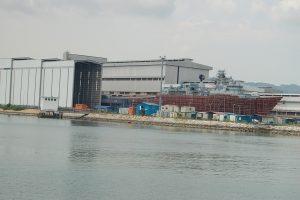In 2011, Malaysian shipbuilder Boustead Heavy Industries was flying high. The company posted 28 million ringgit ($6.6 million) in profit on 301.7 million ringgit in revenue, and ended the year with over 289 million ringgit in cash on hand. Modest debt and other liabilities contributed to a healthy equity buffer and returned solid value for its shareholders, including majority owner Lembaga Tabung Angkatan Tentera, a pension fund for the Malaysian Armed Forces.
In that same year, the Malaysian Ministry of Defense notified Boustead’s associate company, Boustead Naval Shipyard, that it would be awarded a contract to design, build, and commission six next generation littoral combat ships. The contract was finalized in 2014 and had a maximum value of 9 billion ringgit ($2.13 billion).
If you were looking at Boustead Heavy Industries in 2011 – profitable, flush with cash, and with an associate company newly awarded a massive contract to spearhead the Malaysian Navy’s modernization efforts – you would probably be thinking, what could go wrong? As it turns out, quite a lot.
By 2020, Boustead Heavy Industries’ revenue had halved to 145 million ringgit, and it posted negative 50.6 million ringgit in earnings, its third consecutive annual loss. Cash on hand at the end of 2020 had shrunk to just 3.5 million ringgit. Much of this has to do with the perilous financial state of Boustead Naval Shipyard, which has struggled with cost overruns and delays on the littoral combat ship program. The losses have steadily eaten away at Boustead Heavy Industries’ balance sheet.
According to the Annual Report, Boustead Naval Shipyard recorded a loss of 277 million ringgit on 998 million in revenue in 2019, and posted negative 625 million ringgit in equity, meaning their assets cannot cover their liabilities. As of last year, The Edge reported that none of the six ships under contract had been completed and the shipyard might need several billion more ringgit over and above the 9 billion contract value just to complete the work already underway. There have been allegations of missing funds and the government considered cancelling the contract before finally deciding to just muddle through.
Clearly, this has not gone according to plan. But why did it go this way at all? Why did the Malaysian government give the contract to this particular naval yard, whose shareholder structure and board of commissioners is tightly intertwined with the state and the armed forces? On the one hand, it’s not uncommon for preferred defense contractors to have cozy relationships with the government. The logic is that because it’s a nationally strategic industry, it needs to be managed in a way that benefits the national interests of the country rather than the purely financial interests of shareholders. This is a point of view that, in theory, I am sympathetic toward.
But it’s a fine line to walk, especially when the need to balance national and commercial interests is overwhelmed by rent-seeking and ineptitude that result in a situation that benefits neither the national nor commercial interests of anybody, as in this case. Perhaps, given what we now know, it would have been better for Malaysia to lean more heavily on an established foreign manufacturer and develop its littoral combat ship program in partnership with them.
Incidentally, that is what Indonesia did in upgrading its submarine fleet. In 2011, Indonesia signed a contract with South Korea’s Daewoo Shipbuilding & Marine Engineering to procure three submarines for around $1.1 billion. The first two were built in Korea, and the third one was built by PT PAL, a state-owned shipbuilder in Surabaya that is the government’s main naval contractor.
PAL is in many ways the Indonesian equivalent of Boustead Heavy Industries, and its finances are not exactly a picture of health either: it posted a net loss of 304 billion rupiah in 2018 and relies quite heavily on credit from state-owned banks. But it did absorb the transfer of some critical skills and technology from its Korean partner and was, with some hiccups, able to successfully deliver a locally built submarine in the end. Despite Indonesia’s penchant for economic nationalism, this is a strategy they have warmed to, as PAL also recently partnered with Dutch ship-builder Damen to assemble a pair of guided-missile frigates, and there is apparently another 10 trillion rupiah contract in the works to develop two more frigates with a foreign partner.
At the end of the day, PAL’s finances might look only marginally better that Boustead’s, but from a national interest perspective that is fine as long as it results in an accumulation of shipbuilding skills, technology, and know-how that can be used in future projects. As PAL’s only shareholder the Indonesian state is not really looking for a cash dividend. The diffusion of more advanced knowledge and technology is the kind of value it really wants to capture. And while it is too early to make any definitive claim about PAL’s long-term success in that regard, at the moment it certainly seems to faring better than at least one regional competitor.

































